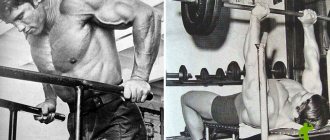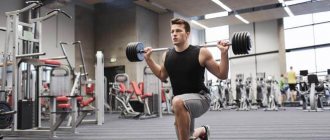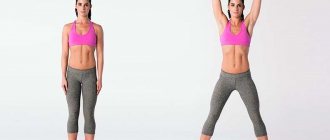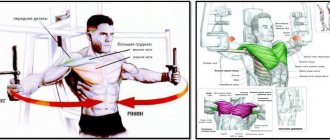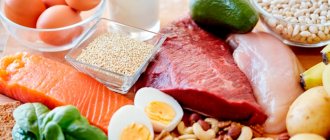What is Pumping
Literally, pumping is pumping, filling. This term comes from the English verb “to pump”. Frequent repetition of the same movement increases muscle blood flow and leads to tissue swelling. At the same time, the concentration of sugar and water increases many times over, the permeability of the cell membrane increases, which creates a feeling of muscle expansion in a specific area of the body.
The pumping effect can be achieved by gradually reducing the weight of the sports equipment, but increasing the speed of training movements and the number of repetitions. During training, it is necessary to maintain amplitude and perform each action as intensely as possible, overcoming pain. At the end of the exercise, the athlete increases the pace, while the blood supply to the tissues increases, and at the end of the workout the muscles increase in volume by up to 20%.
Brief history of origin
Body pump training was developed back in the 90s of the last century by a company that is now known under the Les Mills International brand.
Its employees are coaches, sports scientists and other specialists.
The main goal of the company is to develop training methods that are used for athletes, as well as people who lead an active lifestyle.
A distinctive feature of Les Mills fitness programs is that they are licensed products for commercial use.
They have training programs for home workouts (on digital media) or for group workouts in fitness clubs.
If we are talking about the patented, original Body pump technique, then all instructors teaching it must be certified by Les Mills. They also acquire a license to conduct classes according to the body pump program.
It was this commercial moment that led to the emergence of twin methods.
Body reaction to pumping training
Pumping works physiologically this way:
- The same movements, when duplicated at high speed, lead to the nervous system working in a stressful mode. The brain centers promote increased acceleration of blood flow and send all the necessary substances to the tissues;
- Muscle fibers facilitate the penetration of blood cells into them, which cannot exit immediately due to compression of the capillaries and high tension;
- When the exercise is repeated after a long break, the pressure in the fibers decreases and the blood gradually flows in the opposite direction. Ultimately, the muscle tissue returns to its normal state.
Muscle pumping does not consolidate the result and is called “cosmetic”. Most often it is used by bodybuilders in competitions before going on stage. But if you wish, you can try to develop it into a “productive” form.
“Productive” pumping is adding exercises without rapid repetitions. At some point, increased blood flow is formed, which leads to euphoria. From a psychological point of view, this gives strength and has a great effect on the intensity of the next workout. This constant practice warms up the fascia (the “bags” that contain the muscles) and makes them easier to stretch.
You can achieve muscle swelling with the help of sports nutrition and pharmacology - injections, tablets. But the so-called “Pharmacological” pumping proceeds artificially and can be fraught with health hazards if the sports nutrition is improper.
Video: What is pumping. Its varieties
Pump training and weight loss
Body pump style classes are multifunctional. With their help, they solve several problems at once:
- Reducing subcutaneous fat levels
- Increased muscle tone with slight hypertrophy (increased muscle volume)
- Increased strength and general endurance
- Increasing the body's functional capabilities
- Cardiovascular training
- Strengthening the musculoskeletal system (ligaments, tendons, joints)
The main feature of the body pump method is the combination of long-term aerobic exercise with moderate strength training. This ensures that you burn a lot of calories.
The result is the following:
Basic strength exercises stimulate the release of anabolic hormones, which are responsible for fat burning and accelerating metabolism. And the aerobic component increases the result even more.
Most aerobic exercise does not have this effect. After all, long-term endurance training (running, walking, cycling, etc.) reduces the production of anabolic hormones in the body.
This is expressed in a decrease in overall muscle mass (muscle is “burned” along with fat) and a slowdown in metabolism. Therefore, most people who engage only in aerobic training have a toned figure, but with “flat” bulky muscles.
Pros and cons of pumping
Advantages:
- Pumping does not imply the use of maximum weights. Ligaments and joints are not overloaded during the “saving” mode.
- Since the work is carried out mainly with light weights, the muscles are not damaged as much, which means they recover faster. This same point can also be attributed to the disadvantages of pump training (more on this below);
- The worked part of the body from the rush of blood becomes outwardly attractive - the most convex and prominent;
- The muscle fibers become clogged with lactic acid. This activates increased production of testosterone and somatotropin (growth hormone);
- With the help of open capillaries, thinned membranes of dilated cells and accelerated blood flow, oxygen and nutrients are very quickly delivered to the muscles and are absorbed many times better;
- A dense “cover” is formed around the muscle with the help of connective tissue, which serves as protection from vibrations, shocks, etc. Its advantages are that during training it stretches gradually, its length reserve increases, it can withstand maximum loads and does not tear;
- Constant pumping burns excess subcutaneous fat and forms a clear profile in a very short time.
Flaws:
- The biggest disadvantage of pump training is that you cannot build muscle mass with it. Many studies talk about this. But, 1 or 2 times a month, an athlete can practice pump training in order to “surprise the muscles,” since everyone knows that they get used to monotonous training;
- Each pumping workout is done in the final approach until severe pain occurs. This is not always a desirable and pleasant activity after a heavy strength training session;
- If you overuse intensive and long-term “cosmetic” pumping, it leads to muscle burning. This is dangerous for people who have difficulty gaining weight;
- The nervous system is exhausted - a sign of a stressful state comes from pumping to the brain. The disadvantages are that if repeated frequently it leads to mental overload.
Some tips for home workouts
Before you begin interesting and effective fat-burning activities, you must consider the following recommendations:
- To avoid overload, start your workout with light weights.
- Perform all exercises without sudden jerks and follow the advice of the video trainer.
- Monitor the program updates and gradually increase the load.
- Develop a habit of exercising and do it regularly. In order to get the full effect of your exercises, perform a set of exercises 3-4 days a week.
In short, start with a small load and increase it gradually. Follow the trainer's recommendations and do not overuse the weight of the pancakes. Your barbell should not be too light or too heavy. Everything in moderation. And only then is it possible to count on a quick and 100% result.
Types of Pumping training
Pumping muscles with blood is carried out in several ways. Complexes can be alternated and combined. But not a single pumping workout is possible without strength loads.
Standard workouts
This complex includes basic exercises with dumbbells or a barbell. A large number of repetitions are performed with a minimum of intervals. You can also use the simplest and most well-known exercise for pumping the pectoral muscles - push-ups.
Drop set
This method is also called “Dropping” and consists of performing strength work with a minimum break between approaches and gradually reducing the weight. An example of such pumping training could be the following sets:
Standing dumbbell bicep curls:
- 2 sets of 10 times with a 5-kilogram apparatus in each hand;
- The third approach is 8 times with the same weight, 4 and 5 – 16 times each with 3 kg dumbbells;
- Stretching exercise with final contraction of muscle fibers.
Calf raises on a Smith machine (working weight - 100 kg):
- 4 times 100 kg;
- 3 times 80 kg and 60 kg.
You will find all the necessary information about drop sets in this article.
Super set
It is the most effective pumping method, which combines two different exercises for one muscle group or muscle groups located next to each other. It is necessary to perform elements without skipping repetitions, respites or breaks, otherwise the effectiveness of pumping training will decrease. The athlete can choose the exercises and number of repetitions.
Best pairings for a super set:
- Biceps + triceps - a combination of dumbbell extension from behind the head in a sitting (or lying) position with a classic biceps curl;
- Biceps femoris + quadriceps femoris - performing seated leg extensions and leg presses with working weight.
We wrote in detail about supersets in this article.
Peak contraction
The exercises are performed as usual, but during the approach it is necessary to hold at the very peak for a couple of seconds. For example, when bending your arms with dumbbells, the delay occurs at the highest point.
Partial repetition
This method is recommended to be performed before completing a workout, when you feel tired. Pumping exercises with partial repetitions are very effective, although they are not done at full strength, but at 1/2-1/4 amplitude (shortened amplitude). This may cause severe tingling or burning in the muscles, but this is normal. It is also necessary to observe the number of repetitions from 8 to 10 or more.
Pre-fatigue
This is a very heavy type of pump, but quite effective, with a long-lasting effect. The bottom line is that you initially need to isolate the muscle, and then load it almost to failure. The training program may include the following exercises:
- For triceps: a combination of bench press with a narrow grip and extension of the arms in a block machine;
- On the legs: seated leg extension combined with classic squats.
It is better for novice athletes not to use this type due to its increased risk of injury.
Burning
First, the exercises are performed as usual. But as soon as the athlete feels tired, he begins to sharply increase his speed until his power reserves are fully exhausted.
What type of fitness is body pump?
Body pump is a group strength training workout with a barbell of any weight, which is suitable for both men and women. Body pump complexes contain exercises for all muscle groups, which are performed at a certain tempo to music with a large number of repetitions.
A classic one-hour workout contains the main unchanged parts of the program; only the exercises and their variations change. It takes about five minutes to work each muscle group. Like any workout, pump aerobics begins with a warm-up and ends with stretching.
Multi-repetition and non-stop mode allow you to effectively work out all the muscles, strengthening them, and most importantly help reduce subcutaneous fat. A body pump can be compared to working out in the gym in endurance mode, when more than 15 repetitions are performed per set. Since this mode accelerates the heart rate and increases the supply of oxygen, this workout is aerobic. Therefore, a body pump is considered a strength aerobic exercise.
The weight of the equipment can be selected individually. Each muscle (large, small or medium) is suitable for a certain weight, so resting during the session allows you to change the weight of the equipment and recover.
In an hour of body pump training you can spend more than 600 kilocalories.
